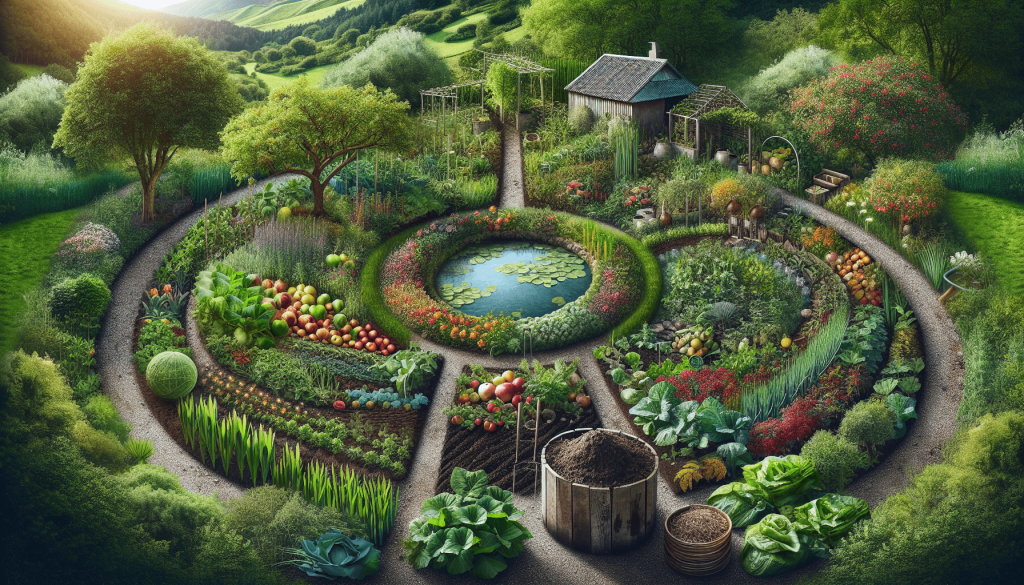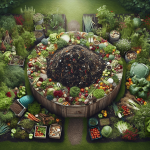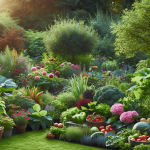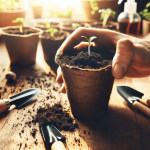This post may contain affiliate links. As an Amazon Associate, we may earn commissions from qualifying purchases.
In this article, you’ll delve into the fascinating world of permaculture, a sustainable gardening methodology that mimics natural ecosystems to create a self-sustaining garden environment. By exploring key principles such as observing and interacting with your garden, utilizing renewable resources, and integrating plants harmoniously, you’ll discover how to transform your backyard into a thriving, balanced habitat. Whether you’re a seasoned gardener or just starting out, you’ll find practical tips and insights to help you cultivate a productive and eco-friendly garden space that flourishes year after year. Have you ever wondered how you can create a garden that practically takes care of itself while providing you with fresh food and a beautiful green space? That’s where permaculture comes into play. Understanding the principles of permaculture will help you develop a garden that is not only sustainable but also resilient and abundant.
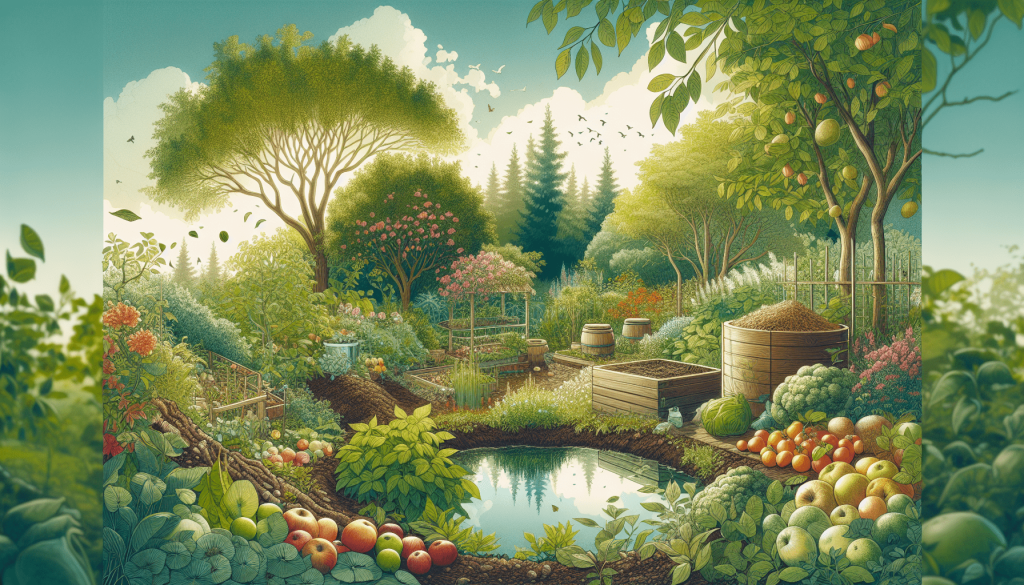
What Are The Principles Of Permaculture?
Permaculture, a term coined from “permanent agriculture” and “permanent culture,” is a holistic approach to designing ecosystems that are sustainable and self-sufficient. Originating in the 1970s with visionaries Bill Mollison and David Holmgren, permaculture draws inspiration from natural ecosystems and combines them with traditional agricultural practices.
1. Observe and Interact
Before diving into gardening, spend some time observing your space. This principle emphasizes the importance of understanding natural patterns, weather conditions, and the unique characteristics of your site.
2. Catch and Store Energy
Whether it’s solar energy, water, or organic matter, this principle is about capturing resources when they are abundant and saving them for times of need.
3. Obtain a Yield
Ensure that your gardening efforts provide a yield. This means creating a system that can produce food, fiber, or other essential resources.
4. Apply Self-regulation and Accept Feedback
Gardening is a dynamic process, and this principle stresses the importance of learning from your mistakes and making improvements as needed. It encourages you to be flexible and responsive to changes.
5. Use and Value Renewable Resources and Services
Prioritize resources that are renewable and systems that minimize waste. Composting, using rainwater, and choosing plants that regenerate themselves are practical applications of this principle.
6. Produce No Waste
In a sustainable garden, every output should become an input in another part of the system. Compost kitchen scraps, recycle materials, and utilize waste products effectively.
7. Design From Patterns to Details
Start by observing broad patterns and then narrow down to specific details. For example, understand the sun’s path before deciding where to plant sun-loving vegetables.
8. Integrate Rather Than Segregate
This principle encourages planting companion plants, integrating animals, and designing ecosystems where components support each other.
9. Use Small and Slow Solutions
Big, fast changes can be destructive. Instead, make incremental improvements to build a resilient garden. Slow growth often leads to a more stable and enduring ecosystem.
10. Use and Value Diversity
Biodiversity enhances resilience against pests, diseases, and extreme weather. A variety of plants, animals, and insects can create a balanced ecosystem.
11. Use Edges and Value the Marginal
Edges, such as fence lines and forest borders, are often the most productive parts of an ecosystem. Make use of these zones to increase yield.
12. Creatively Use and Respond to Change
Gardens are dynamic and ever-changing. Be creative and adaptable to harness these changes to your benefit.
Applying Permaculture Principles to Create a Self-sustaining Garden Ecosystem
Now that you have a good grasp of the permaculture principles, how can you apply them to your garden to create a self-sustaining ecosystem?
Observation and Site Assessment
Spend some time getting to know your garden. Look at:
- Sunlight Patterns: Notice how sunlight moves throughout the day and across seasons.
- Water Flow: Observe how water drains and if there are any areas prone to flooding.
- Soil Quality: Test your soil to understand its composition and fertility.
- Microclimates: Recognize different climate zones within your garden due to factors like shade, wind, and soil moisture.
Catching and Storing Energy
There are many ways to store energy and resources in a permaculture garden. Some methods include:
- Rainwater Harvesting: Use barrels to collect rainwater from gutters.
- Solar Power: Utilize solar panels or solar garden lights.
- Composting: Create compost heaps to recycle organic waste into fertile soil.
| Resource | Ways to Capture and Store |
|---|---|
| Sunlight | Solar panels, greenhouse, reflective surfaces |
| Water | Rain barrels, Swales, ponds |
| Organic Matter | Composting, mulching, worm bins |
Obtaining a Yield
Plant a variety of crops to ensure you have a continual and diverse yield. Consider:
- Annual Crops: Beans, tomatoes, and lettuce are quick to grow and harvest.
- Perennial Vegetation: Trees, shrubs, and perennial vegetables require less maintenance and provide long-term yields.
Self-regulation and Feedback Loops
To create a responsive garden, engage in regular maintenance and observation:
- Pest Management: Look for natural predators like ladybugs and incorporate them.
- Soil Health: Amend soil based on plant performance and health.
- Pruning and Harvesting: Regularly prune plants to encourage growth and prevent disease.
Renewable Resources and Services
Go for materials and systems that have minimal environmental footprints:
- Natural Building Materials: Use wood, bamboo, and stone.
- Recycling and Upcycling: Repurpose old containers, wood, and other materials for garden use.
- Green Energy: Utilize wind or solar energy systems for powering tools and pumps.
Producing No Waste
Ensure that every part of your garden cycle is connected:
- Kitchen Scraps: Compost them rather than sending to landfill.
- Rainwater: Use collected rainwater for irrigation.
- Prunings and Leaves: Turn them into mulch or compost.
| Waste Item | Recycling Method |
|---|---|
| Kitchen Scraps | Composting |
| Pruned Branches | Mulching, Hugelkultur beds |
| Lawn Clippings | Composting, Mulching |
Designing from Patterns to Details
Start your design from large-scale observations and narrow it down to specifics:
- Zones in the Garden: Place high-maintenance plants close to your home and low-maintenance ones farther away.
- Natural Patterns: Utilize the shape of the land, prevailing winds, and water flow paths for natural irrigation.
| Design Element | Considerations |
|---|---|
| Plant Placement | Sunlight, water needs |
| Water Features | Natural drainage flow |
| Walkways and Paths | Convenient access |
Integrating Elements
Ensure that all parts of your garden work together harmoniously:
- Companion Planting: Grow plants together that benefit each other, such as basil and tomatoes.
- Integrate Animals: Chickens can provide eggs and pest control.
| Plants | Companion Plants |
|---|---|
| Tomatoes | Basil, Marigold |
| Carrots | Onions, Chives |
| Beans | Corn, Squash |
Using Small and Slow Solutions
Implement changes gradually to allow the ecosystem time to adjust:
- Soil Improvement: Build up soil health over time by adding compost and organic matter gradually.
- Plant Introduction: Introduce new plant species slowly to give them time to establish.
Valuing Diversity
Incorporate a wide variety of species to create a stable ecosystem:
- Plant Varieties: Include different types of vegetables, herbs, and flowers.
- Pollinators and Animals: Provide habitats for bees, birds, and beneficial insects.
| Aspect | Recommendations |
|---|---|
| Plant Species | Annuals, Perennials, Trees |
| Animal Life | Pollinators, Insectivores |
| Habitats | Birdhouses, Ponds |
Using Edges and Marginal Areas
Don’t overlook the potential of edges:
- Fence Lines: Grow vines or climbing plants.
- Pond Edges: Plant moisture-loving plants like watercress or mint.
Creatively Using and Responding to Change
Stay flexible and adapt to changes quickly:
- Seasonal Changes: Rotate crops based on seasonal growth patterns.
- Climate Variations: Opt for drought-resistant plants during dry seasons.
Practical Steps to Start Your Permaculture Garden
Armed with knowledge of these principles, you can take concrete steps to create your self-sustaining garden.
Step 1: Plan Your Garden Layout
Begin with a simple sketch of your garden. Map out the different zones, considering accessibility and the needs of each plant.
Step 2: Improve Your Soil
Healthy soil is the backbone of a thriving garden. Start composting kitchen scraps and yard waste. Consider:
- Adding Compost: Regularly add compost to your garden beds.
- Mulching: Use organic mulch to retain moisture and protect soil.
Step 3: Water Management
Design a system for capturing and utilizing rainwater efficiently:
- Install Rain Barrels: Position them under gutters to collect water.
- Create Swales: Contour the land to allow water infiltration.
Step 4: Plant Selection
Choose a mix of annuals, perennials, trees, and shrubs. Opt for native species when possible, as they are adapted to your local climate and soil.
Step 5: Companion Planting
Integrate plants that support each other:
- Three Sisters Planting: Combine corn, beans, and squash.
- Herb Borders: Plant herbs around vegetable beds to deter pests.
Step 6: Building Structures
Consider adding supportive structures:
- Raised Beds: Improve drainage and make gardening easier on your back.
- Greenhouses: Extend the growing season and protect plants from pests.
Step 7: Monitor and Adjust
Continually observe and interact with your space. Make notes, take photos, and adjust your strategies based on what you learn.
Conclusion
Creating a self-sustaining garden ecosystem through permaculture principles is not only rewarding but essential for long-term environmental sustainability. By observing your environment, valuing diversity, using renewable resources, and minimizing waste, you can build a garden that thrives with minimal effort.
Remember, permaculture is a journey of learning and adaptation. Start small, stay observant, and enjoy the process of creating a vibrant, resilient garden ecosystem. With each season, you’ll find new opportunities to apply these principles and reap the benefits of all your hard work. Happy gardening!
